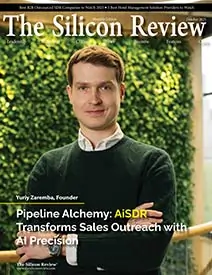50 Most Admired Companies of The Year 2018
An Interview with Red Stag Fulfillment Leadership: A World-Class Fulfillment Company’
The Silicon Review
![]()
“We’re a fulfillment company that approaches things a little differently. Simply put, our company exists to be the successful extension of your business.” – Brad West
On December 26, 2012, investors Jordan Mollenhour and Dustin Gross, (founders of MollenhourGross), discovered the answer to a question they had been asking themselves for over a year at the warehouse where they had outsourced order fulfillment for an eCommerce business they owned. In the past year and a half, the fulfillment company had lost hundreds of thousands of dollars of inventory that belonged to their subsidiary. Thousands of orders hadn’t made it out of the warehouse at all.
Arriving on site, Mollenhour found the floor of the fulfillment center littered with boxes and a foul-smelling break room. As Red Stag Fulfillment President Eric McCollom recalls, “The problem wasn’t a technology gap. It wasn’t a skills gap. It was a cultural gap.” A warehouse where no one wants to come to work won’t be able to provide the excellent fulfillment needed to grow a successful eCommerce business.
The owners knew that fulfillment failures would stunt the growth of their business, if not kill it off altogether. So, in May of 2013, they brought in McCollom to create a new kind of third-party fulfillment provider, one that would provide a new kind of fulfillment services and raise the bar in the logistics industry.
The Beginning: Concept, Culture, and Commitment
“One of the key things that I think set us apart early was that we wanted to be a place that people wanted to work, not a place that people worked because they had to,” McCollom says. The company created systems to provide a new kind of warehouse operation: one with zero shrinkage (merchandise lost or stolen from warehouse shelves), accurate picking and packing, speedy receiving, and efficient shipping.
McCollom knew the culture at the warehouse was even more important than the inventory and shipping systems they put in place. He had to find employees who were willing to work for a startup that no one had ever heard of, walk into an empty warehouse, and build every aspect of the business from scratch. His hardest job, at the beginning, was “convincing the workforce that we were going to be a different kind of company to work for.”
“At the end of the day, it’s about a culture that we’re going to be the best at everything we do,” McCollom says. He was patient, bringing on people who not only had the experience the fledgling company needed but also shared commitment to excellence with which it was founded.
“We got people to buy into creating something from scratch that was different from what was being done,” he says. “And we celebrated our wins.” Maybe that’s why so many original employees are still with the company.
Brad West, Vice President of Operations, has been with Red Stag since the beginning. The culture, he says, is “against the grain from traditional warehousing.” The company doesn’t allow swearing or crude jokes among employees, so it avoids a locker room atmosphere that can quickly turn toxic.
West never wants someone on his team to dread coming to work because of harassment or bad feelings between coworkers. And it’s important to show their best face to clients, who are invited to stop by at any time. “We want to make a great work environment,” he says. “So, we give everybody that works for us a lot of autonomy.” That freedom, plus a sense of ownership, is the secret sauce for Red Stag’s record of excellence.
GSD: Get Stuff Done
“What was crazy to me when I joined was how apparent the culture was,” says Tony Runyan, Vice President of Client Relations and one of Red Stag’s newer hires, who came to the fulfillment company a little over a year ago. He felt the commitment to excellence in everyone from the top management to the floor workers. “There’s this pride in the work that’s done,” he says. When he promotes someone up into management, “the core values are so instilled in them that I don’t have to train them.”
Matt Novak has worked at Red Stag since early 2014. He started out picking and packing orders and worked his way up to Account Manager. “Red Stag is a company that really values its employees,” he says. “As long as you’re willing to do more and ask to do more, they’ll give you those opportunities.”
Chris Molitor, Red Stag’s Vice President of Business Development, who’s been with the company since November of 2013, notes that employees at all levels are encouraged to “think like an owner.” He adds,“It is night and day from a typical place to work.” The attitude can be summed up as GSD – get stuff done. “We’re all focused on the success of the company. We don’t have our own silos and fiefdoms,” Molitor says.
“The level of care that we show to our employees is reciprocated,” West adds. He never has a problem finding volunteers to work late or come in on a holiday, because Red Stag’s workers have such dedication to getting it right for the company’s clients.
Sam Hughett worked at other warehouses, but, “I never worked anywhere that comes close to Red Stag,” he says. “They’re big on employee empowerment.” He started as a picker and packer in July 2013, and he is now Warehouse Manager.
Management comes out on the floor to ask employees for ideas, and Hughett says, “We’ve implemented a lot of them. Everyone feels like they have a say and can give feedback. Their opinions matter.”
How loyal is Hughett? When he moved to a town 60 miles from Red Stag’s Knoxville headquarters, he didn’t give a thought to finding a different job closer to home. “I think it speaks volumes that I would be willing to drive 60 miles to work here,” he says.
A Year of Explosive Growth
Red Stag’s customers are just as impressed by the company as its employees. The Net Promoter Score (NPS) measures what percentage of clients would recommend their services to someone else. Red Stag has a score of 91. “That’s unheard of,” Molitor says. “Most companies score in the 50s and 60s.”
“What our customers say drives everything we do,” Runyan says. The company sends out client surveys and incorporates client requests into its business model whenever feasible.
One thing eCommerce clients want is fast shipping. To reach more US shipping zones in two days or less, Red Stag opened a second warehouse, in Salt Lake City, in 2017. “It’s a beautiful city,” West says of Salt Lake. “It’s growing like crazy.” That makes it a good match for Red Stag, which is also growing like crazy.
It took less than a year to fill Red Stag’s initial Salt Lake warehouse, and there is now a new warehouse with double the square footage and room to triple it. “Red Stag is excited to be part of the city’s economic growth,” McCollom says.
Red Stag brought its culture of excellence to its second location. “Our culture here is so contagious,” says Runyan. “When you walk in, you just have an understanding that people care. We sweat the small stuff.” McCollom adds, “Communicating our values and our vision of the company to a broader audience takes more energy, but we think it’s critical There’s lots of other fulfillment companies, but we want it to be clear that there’s none like Red Stag.”
A Constant Culture of Excellence
In the next few years, Red Stag team members envision the fulfillment company adding fulfillment warehouses in other strategic locations in the US and maybe even internationally. That growth creates big opportunities, in a company with a history of promoting from within the Herd, as Red Stag employees like to call themselves.


 (1)_2025-10-21_13-35-14.webp)

_2025-10-02_10-21-48.webp)

